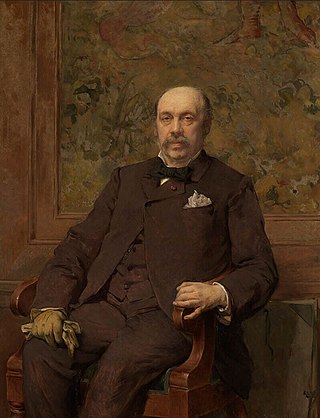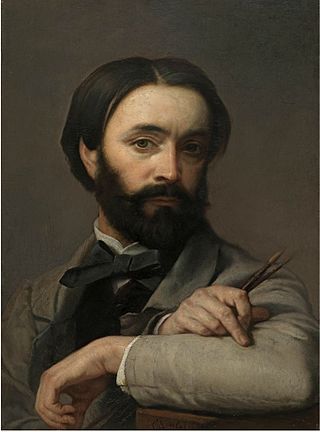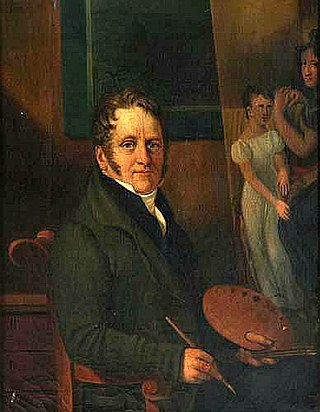
Jacques-Louis David was a French painter in the Neoclassical style, considered to be the preeminent painter of the era. In the 1780s, his cerebral brand of history painting marked a change in taste away from Rococo frivolity toward classical austerity, severity, and heightened feeling, which harmonized with the moral climate of the final years of the Ancien Régime.

Alexandre Cabanel was a French painter. He painted historical, classical and religious subjects in the academic style. He was also well known as a portrait painter. According to Diccionario Enciclopedico Salvat, Cabanel is the best representative of L'art pompier, and was Napoleon III's preferred painter.

Henri Leys, Hendrik Leys or Jan August Hendrik, Baron Leys was a Belgian painter and printmaker. He was a leading representative of the historical or Romantic school in Belgian art and became a pioneer of the Realist movement in Belgium. His history and genre paintings and portraits earned him a European-wide reputation and his style was influential on artists in and outside Belgium.

Alfred Émile Léopold Stevens was a Belgian painter, known for his paintings of elegant modern women. In their realistic style and careful finish, his works reveal the influence of 17th-century Dutch genre painting. After gaining attention early in his career with a social realist painting depicting the plight of poor vagrants, he achieved great critical and popular success with his scenes of upper-middle class Parisian life.
Paul Saintenoy was a Belgian architect, teacher, architectural historian, and writer.

Antoine Joseph Wiertz was a Belgian painter, sculptor, lithographer and art writer. He is known for his religious, historical, and allegorical works and portraits. He was an eccentric figure who originally was much influenced by the works of Peter Paul Rubens and Michelangelo. Some of his works are erotic and macabre and presage Belgian Symbolism. While snubbed by contemporary art critics, he enjoyed the support of the new Belgian state, which in return for his paintings assisted him in building his personal studio/home in Brussels, where the artist worked on his art and writings as a recluse.

Jacques-Émile Blanche was a French artist, largely self-taught, who became a successful portrait painter, working in London and Paris.

Jean-François Portaels or Jan Portaels was a Belgian painter of genre scenes, biblical stories, landscapes, portraits and orientalist subjects. He was also a teacher and director of the Academy of Fine Arts of Ghent and the Académie Royale des Beaux-Arts in Brussels. He is regarded as the founder of the Belgian Orientalist school. He was praised in his time as the premier painter of 'everyday elegance and feminine grace'. Through his art, teaching and his leadership of the Académie Royale in Brussels he exerted an important influence on the next generation of Belgian artists, including his pupil Théo van Rysselberghe.

Armand Massonet was a Belgian painter.

The Royal Academy of Fine Arts of Brussels is an art school in Brussels, Belgium, founded in 1711. Starting from modest beginnings in a single room in Brussels' Town Hall, it has since 1876 been operating from a former convent and orphanage in the Rue du Midi/Zuidstraat, which was converted by the architect Victor Jamaer. The school has played an important role in training leading local artists.

Nicaise de Keyser was a Belgian painter of mainly history paintings and portraits who was one of the key figures in the Belgian Romantic-historical school of painting.

Germán Gedovius (1867–1937) was a Mexican painter.

Charles Verlat or Karel Verlat was a Belgian painter, watercolorist, engraver (printmaker), art educator and director of the Antwerp Academy. He painted many subjects and was particularly known as an animalier and portrait painter. He also created Orientalist works, genre scenes, including a number of singeries, religious compositions and still lifes.

Constant Montald was a Belgian painter, muralist, and teacher.

Mattheus Ignatius van Bree was a Belgian painter. He was one of the founders of the historical school of painting in Belgium and played an important role as a teacher in the development of 19th-century Belgian art.

Évariste Carpentier was a Belgian painter of genre scenes and animated landscapes. Over the years, his painting evolved from academic art to impressionism. Alongside Emile Claus, he is one of the earliest representatives of luminism in Belgium.
Despite its size, Belgium has a long and distinguished artistic tradition that goes back to the Middle Ages, considerably pre-dating the foundation of the current state in 1830. Art from the areas making up modern Belgium is called in English Netherlandish up to the separation with the Netherlands from 1570 on, and Flemish until the 18th century.

Victor Gilsoul (1867–1939) was a Belgian impressionist, luminist and painter who worked mostly on commissions from the European nobility.

Joseph Denis Odevaere, or Joseph-Désiré Odevaere, was a Neo-Classical painter from the Southern Netherlands. He served as court painter to King William I.

Albrecht Frans Lieven De Vriendt or Albrecht De Vriendt was a Belgian painter known for his genre scenes, history paintings, interiors and figure paintings. He was also active as an author, publisher and copyist He was also a watercolorist and an etcher. He participated in the monumentalist movement in Belgium and continued the tradition of the Belgian Romantic-historical school long after it had been abandoned in his country and abroad. He was the brother of the painter Juliaan De Vriendt with whom he often collaborated on decorative projects. He was a director of the Royal Academy of Fine Arts of Antwerp.

















